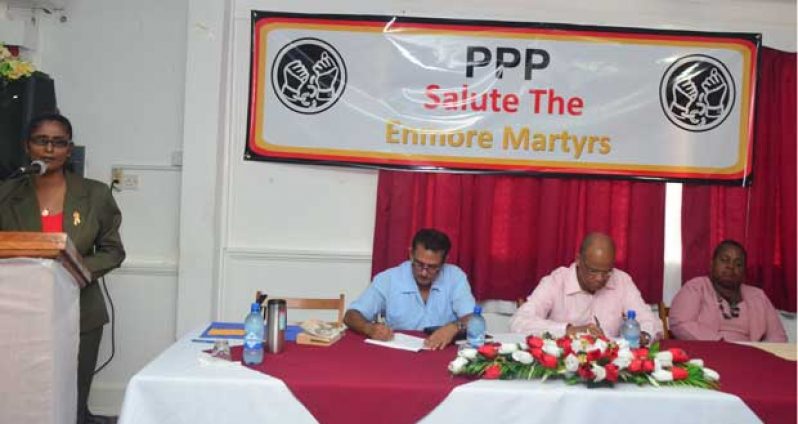A poignant reminder of Enmore Martyrs’ bravery
–in the face of adversity
THE People’s Progressive Party (PPP) last Wednesday evening hosted a session at the Cheddi Jagan Research Centre (Red House) where members of the public were engaged in reflections on the 66th Death Anniversary of the Enmore Martyrs.
The aim of this event was to educate the public on the struggles of the five sugar workers – Lallabagee, Rambarran, Pooran, Surujballi and Harry — who were shot and killed by the colonial police on June 16, 1948, during a strike.
General Secretary, Clement Rohee, during his address, stated that this historic protest and picketing exercise outside of the Enmore Factory was to express the general dissatisfaction of sugar workers with the cut and load system at the sugar factory, in collaboration with the trade union representing them, and to demand higher wages and better living conditions.
Rohee reflected that on June 16, 1948, a crowd of workers gathered outside the factory at Enmore for a protest and picketing exercise. Several persons managed to enter the compound. The police tried to push back the crowd, but after this effort failed, they opened fire. Five workers were killed and others were injured. These workers, through the years, became known as the Enmore Martyrs.
“If the People’s Progressive Party/Civic did not keep the fire for this historical event, then it would have been dead today,” he said. This event represents one of the turning points in the country’s history, as it highlighted several strands of the economic struggles that were occurring in Guyana.
According to Rohee, this protest was in response to the struggles and oppression that the sugar workers were subjected to, which had become unbearable; living conditions were beyond deplorable, many of them were living in logies and opportunities for education were almost non-existent and so were health facilities.
He pointed out that Dr. Cheddi Jagan dedicated his life to the struggle for the people of Guyana. “Two years (1950) after this event, the People’s Progressive Party was formed. In 1953, the PPP won the election and Dr. Cheddi Jagan became Prime Minister. However, 100 days after the PPP came into power the British authorities sent in troops and the PPP were thrown out,” he recalled.
He also highlighted that the PPP won the 1961 elections. In 1964, the PPP again won the elections in terms of percentage and total votes; however they were removed. It finally returned to power in the 1992 elections, and remains in power today.
Rohee lamented the fact that it has been a continuous struggle for the PPP/C since the formation of the party to now. “At every election, from 1992 to today, it was a struggle… Today, the struggle continues. Every trick and maneuver is being used to get the PPP/C out of government.”
He concluded by saying that the PPP/C will continue to struggle for the betterment of the people in Guyana. He noted, “Even though the sugar workers worked in an industry that produced sweet, their life was bitter… Enough is enough!” We as citizens must recognise the significance of the struggles of the Enmore Martyrs.
Speaking at Red House also, the General Secretary of the Guyana Agriculture and General Workers’ Union (GAWU), Seepaul Narine, pointed out that this event resulted in the transformation of our country. He pointed out that the real aim of the strike was to demand recognition of the GIWU as the bargaining union for the field and factory workers on all the sugar estates in the country.
He added that Dr. Jagan himself was personally involved in the strike, and Janet Jagan was also in the forefront in operating soup kitchens for the striking workers and their families on the sugar estates.
Narine mentioned that the retaliation of the British was to scare the workers not to be engaged in struggles pertaining to their working condition.
Chairperson of the Women’s Progressive Organisation (WPO), Gillian Burton-Persaud, pointed out that this event is to celebrate the five sugar workers who paid the ultimate sacrifice for daring to stand up to the colonial estate management.
According to her, the workforce on the estates contained at least 30 per cent of women. They worked in the gang responsible for weeding and putting manure to the sugarcane plants. They were the architects of the protest because of the hardship their male counterparts were facing on the sugar estates, with very little time to care for their children and the conditions they had to work under.
She mentioned that the tragedy and the ultimate sacrifice of these sugar workers greatly influenced Dr. Jagan’s political philosophy and outlook as he made a silent pledge that he would dedicate his entire life to the cause of the struggle of the Guyanese people against bondage and exploitation.
Burton-Persaud noted that “Due to the hard work of Dr. Cheddi Jagan and Janet Jagan, the women now enjoy better and equal salaries as their male counterparts, maternity benefits, pensionable jobs, direct and unhindered involvement in a trade union of their choice, the opportunity to let their voices be heard on any issue affecting them, the right to negotiate or bargain for better working conditions, the opportunity to be community and political leaders and most significantly, the right to vote for betterment of their choice.”
And Education Secretary of the People’s Progressive Party, Hydar Ali, also spoke of the deplorable living conditions of the sugar workers at that time.
Enmore Martyrs’ Day is observed annually in remembrance of the five sugar workers who were shot and killed on June 16, 1948, by colonial police while they were demonstrating for better working conditions.
(By Sandy Agasen)



.jpg)









